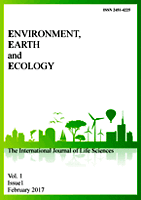ORIGINAL PAPER
Assessment of Cytotoxic Ions Sequestration as salt tolerant indicators in Tomato (Solanum lycopersicum L.)
| 1 |
Federal university Birnin Kebbi. Nigeria |
| 2 |
Usmanu Danfodiyo University, Sokoto, Nigeria |
Environ. Earth Ecol. 2018;2(1):28-33
KEYWORDS
TOPICS
ABSTRACT
This study determines the genetic diversity of 20landraces and released cultivars of tomato collected from Market places and research institutes in Nigeria. Ion homeostasis and cytotoxic sequestration significantly (P>0.05) affected by concentration of salt in a concentration dependent manner. Accumulation of Na+, Cl-, K+ and Ca2+ ions increased in salt treated groups (30 and 60 mg/L of NaCl) as compared to controls. Potassium ion uptake was salt concentration dependent in all cultivars; the magnitude of Na+/K+ levels is lower in released cultivars than in landraces cultivars. It can be concluded from these findings that Na+ was compartmentalized both in tomato by membrane transporters and that low level was a good indicator of salt tolerant in tomato genotype studied.
Corresponding author
Ja'afar Umar 
Federal university Birnin Kebbi. Nigeria, Biology Department Federal university Birnin Kebbi. Nigeria, 1017 Burnin Kebbi, Nigeria
REFERENCES (13):
| 1. |
Berntein L (1995) Osmotic Adjustment to Saline Media. American Journal of Botany, 43, 909 - 918.
|
| 2. |
Chattopadhyay MK, Tiwari BS, Chattopadhyay G ( 2002) Protective roles of exogenous polyamineson salinity stressed in rice plant. Physiology of plants. 116: 192 - 199.
|
| 3. |
Dudly A (1992) Growth and Yield of Vegetable. Crop Science 21, 891-900.
|
| 4. |
Jamil M, Rha ES (2006) The effect of Salinity (NaCl) on the germination and seedling ofsugar beet (Beta vulgari L.) and cabbage (Brassica oleraceae L.) Korean J. Plant Res. 7, 226-232.
|
| 5. |
Lira LY, Li S, Showalter M (2014) Immunolocalization of extention and potato.Physiogia Plantarum 97, 708-718.
|
| 6. |
Maathius F, Flowers TJ, Yeo AR (1992) Sodium chloride compartmentation in leafvacuole of halophyte Suaeda maritime L. and its relation to tonoplast permeability. Journal of Experimental Botany 43, 1219-1223.
|
| 7. |
Mohr F (2003) Protocols on Extraction of ions in plant samples. Hamdad University, NewDelhi. Pp 23-27.
|
| 8. |
Munns R (2002) Comparative physiology of salt and water stress. Plant Cell Environ. 25: 239 - 250.
|
| 9. |
Prat D, Fathi- Ettai RA (2013) Variation in organic mineral component in young Eukalyptus seeding under saline stress.Journal of Plant Physology. 79: 479-498.
|
| 10. |
Rains DW (1989) Plant Tissue and Protoplast Culture: Application to Stress Physiology andBiochemistry. In: Plant under Stress. Eds. J.H. Flowers, M.B. jones, Cambrigde University Press, London, 181-197.
|
| 11. |
Sairam W, Tygyi SA (2004) Effects of Soil Salinity on Germination and Crop Yield.Journal of Environmental Science. 43-49.
|
| 12. |
Shininger TL (1997) The control of vascular development. Annual Review of PlantPhysiology30, 313-337.
|
| 13. |
Zhu JK (2001) Plant salt tolerance. Trends Plant Science. 6: 66-71.
|








